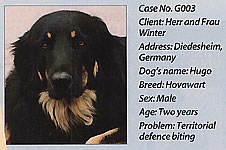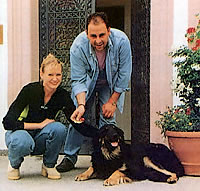|
DOGS
TODAY November 1997
|
||
 |
Peter
Neville's TRUE CASE HISTORIES |
|
 Dear
Michael,
Dear
Michael,
We purchased Hugo and his brother Nax to act as guard dogs for our estate.
We have done our best to socialise them to he friendly with our many visitors
when we or our staff are around, but to be a deterrent to would-be intruders.
This worked extremely well under your guidance and early training programme. But recently Nax, the more assertive of the two dogs, has gone to stay with our son in the countryside for a few weeks, leaving Hugo on sole duty. The responsibility seems to have gone to his head, because he has become more assertive in his greetings.
We started to worry a couple of weeks ago when he nipped four people in a couple of days, fortunately without serious repercussions. Then he seemed to calm down and returned only to barking and settling down once visitors had come through the gate. But this morning he bit our doctor quite badly as he tried to cross from the gate to the house. Fortunately, the doctor likes dogs, but now we are very concerned about Hugo's behaviour.
Please
help return him to his old watchful but safe self.
Yours
sincerely,
Monica and Jurgen Winter
With the rapidly growing practice of pet behaviour therapy throughout Europe, I took a busman's holiday in July to visit one of the top therapists and trainers in Germany. I went to see my old friend Michael Eichhorn to observe him at work and help (or hinder) his treatments. For the next three True Case Histories, we'll be looking at some of his typical cases, comparing the difference in problems, dogs, clients and their expectations, and approaches to treatment in Germany. Of course, it's pure coincidence that Michael happens to live in Pflaz, one of the major wine-growing regions of Germany, and that there are wine festivals throughout July in the beautiful town of Forst where Michael lives.
Hooch
was clearly feeling vulnerable since his confident brother had gone away
for a few weeks' holiday, and was therefore reacting more enthusiastically
to the entrance of visitors. Michael followed a reliable British-designed
approach to this problem, with a treatment programme using a willing volunteer
or two and preconditioning the dog with John Fisher's famous dog Training
Discs. For those who haven't heard of dog Training Discs and the astonishing
training technique they allow, they are five small brass discs on a fob
which create a unique sound like keys or pebbles in a can. The discs are
designed to be picked up, carried and put down without making a noise,
so they can be used at exactly the right moment to interrupt unwanted
canine behaviour without inadvertently causing a reaction at any other
time.
Compact discs
 |
|
Michael,
holding the dog training discs, and Ann with Hugo
|
Hugo was introduced to the sound of the discs by Michael, who had known Hugo as a puppy and seen him at his early training classes long ago. Away from any visitors, a few favourite titbits were placed on the floor and the discs dropped near to Hugo, but not thrown at him, as he stopped to eat them. After two or three such experiences, he became wary of approaching the food and looked a little confused, a typical avoidance reaction resulting from 'frustrative non-reward'. At this point, in England, we would have asked the owners to reassure their dog, so that he would then stop, look and listen when he heard the sound of the discs, and subsequently turn to familiar people for support.
The owner can then encourage him to perform an alternative behaviour, such as coming to heel or lying down, which they reward. The dog steadily learns to avoid repeating the previous unwanted actions, and happily, and most importantly, calmly learns to focus his attention onto the owner when the original arousing stimulus is presented without the discs. Once the dog has been tuned in to the discs, their scope can be broadened and used to interrupt any unwanted behaviour, including territorial defence behaviour. However, with this type of problem the method often continues to rely on the presence of the owner or familiar people to offer the dog alternatives, and is less reliable in their absence. In the UK, the technique is mainly employed for effective signalling and communication in training when the dog is accompanied by the owner. But this was Germany, and the discs were being used to treat a problem knowing the dog was being left unsupervised to roam the premises without anyone being on hand to reinforce an alternative behaviour after the avoidance, Michael simply wanted an avoidance reaction from Hugo when guests entered his owners’ premises, so that they would be safe. In effect, he wanted Hugo to learn to gain the emotional reward of relief when he retreated out of the way.
Having
grasped that the sound of the discs meant calm, resigned failure of intention,
Hugo was now introduced to Michael’s willing volunteers, who were
to come through the gate unannounced – first me, and then my girlfriend,
Ann. Hugo now learned that the arrival of a visitor produced the sound
of the discs. As I came through the gate and Hugo advanced, Michael dropped
the discs from a window onto the cobbled courtyard. It usually takes more
than one such introduction, but Hugo took one look at me and immediately
left the area. This would be fine in an average-sized house, but the Winter’s
estate was so huge it took Michael 10 minutes to find Hugo at the far
end of the garden, He was perfectly relaxed and happy, and had dealt with
the problem of a visitor simply by getting right out of the area. Michael
brought him back to his kennel and did exactly the same thing when Ann
came through the gate – but this time he left for his hideaway without
the discs even being used, Problem solved – for today, at least.
Regular
exercise
This technique clearly proved an invaluable way of reshaping Hugo’s
behaviour and avoiding any potential confrontation with visitors. All
Michael wanted to do afterwards was to repeat the exercise several times
until he was sure Hugo would always react this way when unfamiliar visitors
entered, while remaining relaxed and present to greet friends and family.
But I believed Michael was lucky that Hugo was sensitive enough to the
discs to connect them with unfamiliar callers, take such safe avoiding
action, and even have the space to do so at all.
Michael believes the power of the discs is often even greater if the owners are not part of the learning process when the discs are first introduced. Problems such as Hugo’s are common among Michael’s clients who have larger properties, and so the technique of introducing a calm yet dramatic avoidance response is invaluable. I had to agree with him, especially when he took me to visit a Rottweiler and a Bouvier nearby who had been just as responsive to the same approach. They were just as safe for callers who entered the premises, while still being an active and effective deterrent to those who waited outside, Simply being big and being there is an effective enough deterrent for most would-be wrong-doers and is a lot safer for visiting doctors.